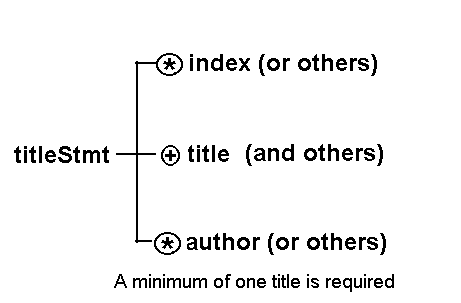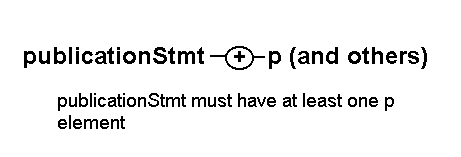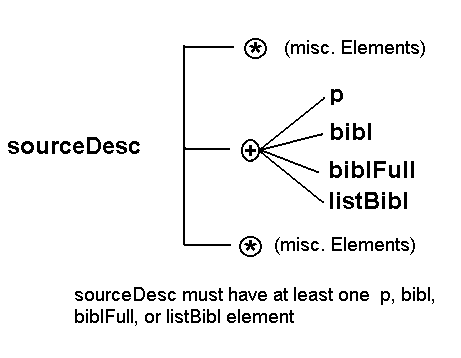![[The HTML Writers Guild Logo]](../../images/lo-025.gif)
The HTML Writers Guild

![[The HTML Writers Guild Logo]](../../images/lo-025.gif) |
|
||
The teiHeader of the teixlite dtd Contains all the meta data concerning the document that is to be marked up. At a minimum it must contain a 'fileDesc' element. This element ('fileDesc' element), takes three obligatory elements and two optional elements. The following diagram illustrates this.

The diagram shows that this element must take one and one only each of a titleStmt and a publicationStmt element, and at least one sourceDesc element. The other elements are optional
Here is the relevant 'fileDesc' element declaration.
<!ELEMENT fileDesc (titleStmt, editionStmt?, extent?, publicationStmt, seriesStmt?, notesStmt?, sourceDesc+) >
Here is a brief look at the required content for the obligatory elements

The only obligatory element content is a title element, and this can only occur once.
Here is the relevant 'titleStmt' element declaration.
<!ELEMENT titleStmt ((index | interp | interpGrp | lb | milestone | pb | gap | anchor)*, (title, (index | interp | interpGrp | lb | milestone | pb | gap | anchor)*)+, ((author | editor | sponsor | funder | principal | respStmt), (index | interp | interpGrp | lb | milestone | pb | gap | anchor)*)*) >
The title element would of course contain the title of the book, and the title element(s) the name(s) of the author(s). See the official documentation for the semantics of the other elements.
Here is a titleStmt from one of Zane Grey's novels.
<titleStmt>
<title>The Riders of the Purple Sage</title>
<author>Zane Grey</author>
</titleStmt>
The publicationStmt element
groups information concerning the publication or distribution of an electronic or other text.

The only obligatory element content is a minimum p element and/or an element from the following group (publisher | distributor | authority | pubPlace | address | idno | availability | date). (See element declaration below.)
Here is the relevant 'publicationStmt' element declaration.
<!ELEMENT publicationStmt ((p, (index | interp | interpGrp | lb | milestone | pb | gap | anchor)*)+ | ((publisher | distributor | authority | pubPlace | address | idno | availability | date), (index | interp | interpGrp | lb | milestone | pb | gap | anchor)*)+) >
The publicationStmt element would most likely contain information about the publication of the text. For example an Etext may have information about the original publisher, and who scanned and marked up the text for Project Gutenberg. The Gutenberg Blurb will most likely go in a publicationStmt element.
The sourceDesc usually supplies a bibliographic description of the copy text(s) from which an electronic text was derived or generated. However this is often not available in Project Gutenberg Etexts as they are can be derived from several sources.

The sourceDesc element Must contain one of the following elements (p | bibl | biblFull | listBibl). The other elements are optional.
Here is the relevant 'sourceDesc' element declaration.
<!ELEMENT sourceDesc ((index | interp | interpGrp | lb | milestone | pb | gap | anchor)*, ((p | bibl | biblFull | listBibl), (index | interp | interpGrp | lb | milestone | pb | gap | anchor)*)+) >
Here is a typical sourceDesc from a Gutenberg Etext
<sourceDesc>
<p>From a Gutenberg Etext, Riders of the Purple Sage
by Zane Grey. Etext prepared by Bill Brewer, billbrewer@ttu.edu.
Markup by Frank Boumphrey.
</p>
<p>Project Gutenberg Etexts are usually created from
multiple editions, all of which are in the Public Domain in
the United States, unless a copyright notice is included.
Therefore, we do NOT keep these books in compliance with any
particular paper edition, usually otherwise.
</p>
</sourceDesc>
The notesStmt collects together any notes providing information about a text additional to that recorded in other parts of the bibliographic description. In Gutenberg etexts it is a convienient place to put acknowlegements that should appear at the head of the texts. Note that notesStmt element must come before the sourceDesc element.
Here is a typical notesStmt from a Gutenberg Etext
<notesStmt>
<note>A Production of Project Gutenberg and the
HTML Writers Guild. Etext prepared by Bill Brewer,
billbrewer@ttu.edu. Markup by Frank Boumphrey. March 2000
</note>
</notesStmt>
(See the tei1.css for an example of how this is displayed)
In the next section we will look at top level elements for marking up the document proper.